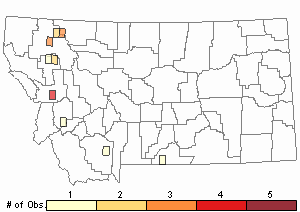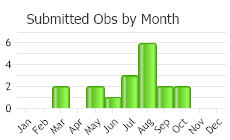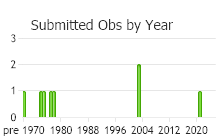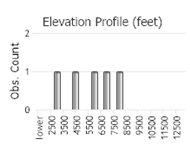View in other NatureServe Network Field Guides
NatureServe
Montana
Utah
Wyoming
Idaho
Wisconsin
British Columbia
South Carolina
Yukon
California
New York
A Dicranum Moss - Dicranum muehlenbeckii
General Description
Plants: Acrocarpous. Growing in crowded clumps of erect shoots, green, green with yellow tones (FNA 2007), or brown with yellow tones (Crum & Anderson et al. 1981), not shiny. Stems 3-7 cm tall; rhizoids russet and thickly covering the stem with woolly matting (FNA 2007).
Leaves: Strongly curled or twisted when dry, smooth and spreading somewhat when moist, 4-8 mm in length, 0.5-1 mm in width, lance-shaped, cupped below, not wavy, the infolded margins above creating a tube (FNA 2007), tapering slowly to the acute leaf tip (Crum & Anderson et al. 1981); margins smooth to a little saw-toothed distally; costa extending beyond the apex, sometimes faintly dentate above on the dorsal side, lacking dorsal crests (FNA 2007).
Leaf Cells: Lamina 1 cell-layer thick, the cells sometimes a little rough on the dorsal surface, the cell walls between cells bulging a little; upper laminal cells square to quadrangular, sometimes oddly angled, not porose; lower laminal cells quadrangular (FNA 2007) or widely oblong (Crum & Anderson et al. 1981) to linear (Lawton 1971), weakly porose; alar cell region typically greyish (Crum & Anderson et al. 1981), in 2 layers, distinct, occasionally reaching the costa; costa in X-section with ventral and dorsal stereid bands reaching the apex, guide cells in 1 row, cells of the ventral and dorsal superficial layers distinct from the adjacent stereids (FNA 2007).
Phenology
Fruit ripens in summer (FNA 2007).
Diagnostic Characteristics
Frequently misidentified as other Dicranum species. Keeping in mind leaf conditions when moist and dry, the tubulose distal part, the unistratose lamina with smooth cells, and the costa’s differentiated cells of both ventral and dorsal epidermal layers should lead to a correct identification (FNA 2007).
Range Comments
North American Range
A somewhat scarce species found in AK to NB and NL (except NU, AB and PE), MT and ND s to NM and NE (FNA 2007). Known in Montana from Custer, Flathead, Glacier, Lake, Lincoln, Madison, Missoula, Park, and Sweet Grass Counties (FNA 2007).
Observations in Montana Natural Heritage Program Database
Number of Observations: 18
(Click on the following maps and charts to see full sized version)
Map Help and Descriptions
Relative Density

Recency



 (Observations spanning multiple months or years are excluded from time charts)
(Observations spanning multiple months or years are excluded from time charts)
Habitat
Gritty soil and humus overlying and among stones; uncrowded woodlands or unsheltered areas. Elevation: 30-10,170 feet (FNA 2007).
Reproductive Characteristics
Small male plants growing epiphytically on female plant rhizoids. Inner perichaetial bracts enveloping the stem, suddenly narrowing to the short acumen. Seta single, 15-35 mm tall, yellow to ochre. Capsule bowed to nearly straight, 2-4 mm in length, tilted to nearly vertical, faintly longitudinally lined when dry; beak similar in length to the theca, tilted to straight (Lawton 1971); peristome of 16 teeth, separated ca halfway down into 2 lobes (seldom 3), russet, with papillae above. Calyptra hood-like, hairless, sheltering much of the capsule, falling away easily (FNA 2007).
References
- Literature Cited AboveLegend:
 View Online Publication
View Online Publication Crum, H.A. and L.E. Anderson. 1981. Mosses of Eastern North America. 2 volumes. Columbia University Press, New York. 1328 pp.
Crum, H.A. and L.E. Anderson. 1981. Mosses of Eastern North America. 2 volumes. Columbia University Press, New York. 1328 pp. Elliott, J.C. and A.K. Pipp. 2018. A Checklist of Montana Mosses (1880-2018). Updated 3 January, 2020. Montana Natural Heritage Program, Helena, Montana. 73 pp.
Elliott, J.C. and A.K. Pipp. 2018. A Checklist of Montana Mosses (1880-2018). Updated 3 January, 2020. Montana Natural Heritage Program, Helena, Montana. 73 pp. Flora of North America Editorial Committee, eds. 2007. Flora of North America North of Mexico. Volume 27. Bryophytes: Mosses, Part 1. Oxford University Press, Inc., NY. xxi + 713 pp.
Flora of North America Editorial Committee, eds. 2007. Flora of North America North of Mexico. Volume 27. Bryophytes: Mosses, Part 1. Oxford University Press, Inc., NY. xxi + 713 pp. Lawton, E. 1971. Moss Flora of the Pacific Northwest. Hattori Botanical Laboratory. Japan: Yamabuki-cho, Shinjuku-ku, Tokyo. 362 pages plus appendices.
Lawton, E. 1971. Moss Flora of the Pacific Northwest. Hattori Botanical Laboratory. Japan: Yamabuki-cho, Shinjuku-ku, Tokyo. 362 pages plus appendices.
- Additional ReferencesLegend:
 View Online Publication
View Online Publication
Do you know of a citation we're missing? Elliot, J. C. 1993. Second checklist of Montana mosses. Unpublished report. U.S. Forest Service, Region 1. Missoula, MT. 45 pp.
Elliot, J. C. 1993. Second checklist of Montana mosses. Unpublished report. U.S. Forest Service, Region 1. Missoula, MT. 45 pp. Lawton, E. 1971. Keys for the Identification of the Mosses on the Pacific Northwest. Reprinted from 'Moss Flora of the Pacific Northwest'. Published as Supplement No. 2 of the Journal of the Hattori Botanical Laboratory. Nichinan, Miyazaki, Japan. 66 pp.
Lawton, E. 1971. Keys for the Identification of the Mosses on the Pacific Northwest. Reprinted from 'Moss Flora of the Pacific Northwest'. Published as Supplement No. 2 of the Journal of the Hattori Botanical Laboratory. Nichinan, Miyazaki, Japan. 66 pp.
- Web Search Engines for Articles on "A Dicranum Moss"





